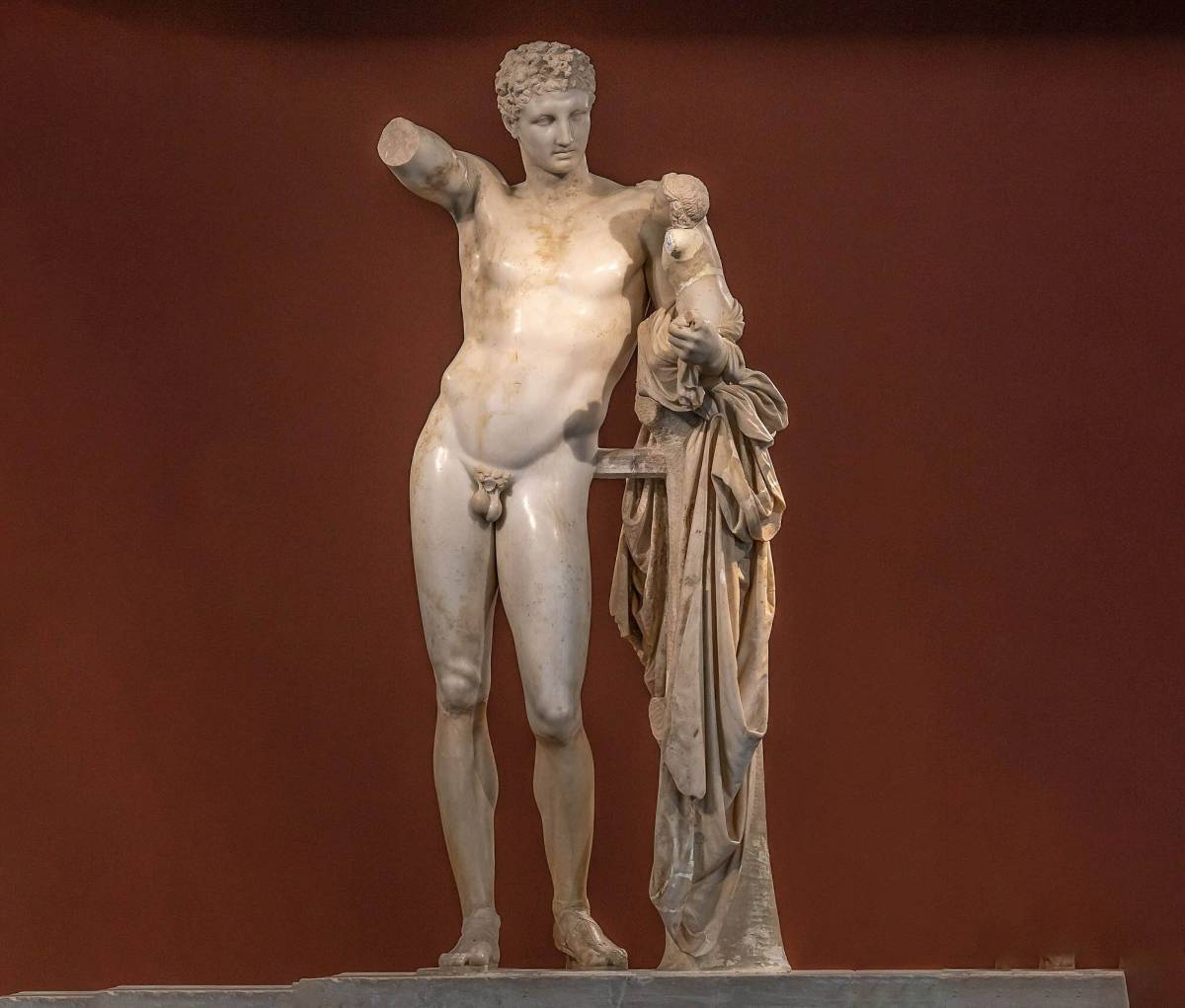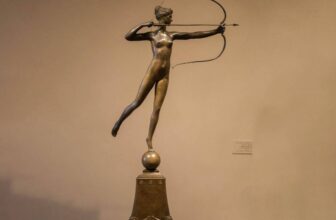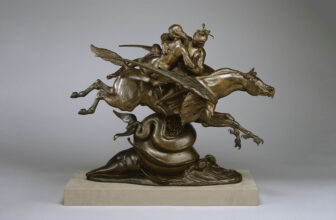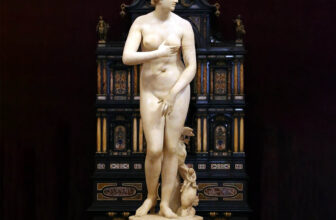
Hermes and the Infant Dionysus Sculpture: Story and Legacy
The marble sculpture known as Hermes and the Infant Dionysus, attributed to the renowned Athenian sculptor Praxiteles, stands today as one of the most celebrated artifacts of Greek art. Found in the ruins of the Temple of Hera at Olympia in 1877, the statue represents not only a pinnacle of classical artistry but also a profound mythological narrative about the gods Hermes and Dionysus. To fully appreciate its significance, one must look at the story behind the sculpture, its meaning, the symbolism it carries, and the reasons for its enduring fame.
The Mythological Story of Hermes and Dionysus
To understand the statue, we must first turn to Greek mythology.
The Birth of Dionysus
Dionysus, later revered as the god of wine, fertility, and theater, had a complicated and miraculous birth. His father was Zeus, king of the gods, and his mother was the mortal woman Semele, daughter of King Cadmus of Thebes. Hera, the jealous wife of Zeus, discovered the affair and devised a plan to destroy Semele. Disguised, Hera convinced Semele to ask Zeus to reveal himself in his true divine form. Bound by oath, Zeus complied. When he appeared in his blazing, thunderous glory, Semele, unable to withstand the divine radiance, perished.
Yet Zeus managed to save the unborn child. He sewed the fetus into his own thigh until the baby came to term. Thus, Dionysus was twice-born: once from his mortal mother, and once from the body of Zeus.
The Role of Hermes
Hera’s wrath did not stop with Semele’s death. She sought to destroy Dionysus as well. To protect the infant god, Zeus entrusted Hermes, the swift-footed messenger and protector of travelers, with carrying Dionysus away to safety.
In some versions of the myth, Hermes carried Dionysus to the nymphs of Mount Nysa, who would raise him in secret. In others, Hermes delivered the infant to King Athamas and his wife Ino, Semele’s sister, who cared for the child disguised as a girl to hide him from Hera. The nurturing of Dionysus was always cloaked in secrecy and protection, themes central to his myth.
This protective and transitional moment is exactly what Praxiteles captured in marble: Hermes pausing on his journey, holding the child Dionysus. The story is one of rescue, care, and the divine interplay of vulnerability and immortality.
The Meaning of the Hermes and the Infant Dionysus Sculpture
An Artistic Pause in Divine Action
The sculpture depicts Hermes standing gracefully, cradling the infant Dionysus in his left arm. Hermes leans slightly, his figure relaxed, his weight shifted onto one leg in the classical contrapposto pose. Dionysus, small and playful, reaches upward toward Hermes, perhaps for a cluster of grapes that Hermes is believed to have once held in his outstretched right hand (now missing).
This moment is not one of frantic flight but of tranquil pause. Hermes, the god of boundaries and transitions, is shown in a rare intimate moment, pausing in his duty to comfort the child. The stillness contrasts with the larger story of danger and pursuit, emphasizing the humanity of the gods in their acts of care and protection.
The Message of Care and Protection
The sculpture represents the divine guardianship of innocence. Hermes is often portrayed as a cunning trickster or fleet-footed messenger, but here he takes on a nurturing role. Dionysus, the god who will later embody ecstasy, revelry, and transformation, is shown as a vulnerable child needing protection. This duality between vulnerability and divinity is central to the sculpture’s meaning.
Symbolism of Hermes and the Infant Dionysus
The sculpture carries layers of symbolism that reflect both myth and philosophy:
Transition and Passage
Hermes is the god of transitions, boundaries, and movement between worlds. In this sculpture, he embodies the transitional moment between danger and safety, between infancy and future divinity.
The Grapes and Dionysian Symbolism
Scholars believe Hermes once held a cluster of grapes, which the infant Dionysus reached for. Grapes, of course, are symbolic of Dionysus’ later dominion over wine, ecstasy, and theater. The gesture foreshadows his destiny as the god of intoxication and festivity.
Contrapposto and Human Realism
The relaxed stance of Hermes, the soft modeling of flesh, and the lifelike proportions symbolize Praxiteles’ artistic revolution: gods represented with human tenderness and realism, not just as remote, idealized figures.
Divine Vulnerability
By showing Dionysus as an infant, the sculpture highlights that even gods undergo stages of growth, vulnerability, and dependence. This resonates with the Greek philosophical idea that gods mirrored human experiences, bridging mortal and immortal realms.
The Balance of Roles
Hermes is both a trickster and protector, while Dionysus is both vulnerable child and future powerful god. The sculpture symbolizes balance and transformation, themes central to Greek thought.
Why Is the Hermes and the Infant Dionysus Sculpture Famous?
Several factors contribute to its enduring fame:
Attribution to Praxiteles
Praxiteles (4th century BCE) was one of the greatest sculptors of ancient Greece, known for introducing grace, naturalism, and sensuous beauty into classical art. His works, such as the Aphrodite of Knidos, were revolutionary. Hermes and the Infant Dionysus is believed to be an original work of Praxiteles (though some debate it as a later copy), making it one of the rare surviving connections to his artistry.
Discovery at Olympia
The statue was uncovered in 1877 during excavations at the Temple of Hera in Olympia, one of the most sacred sites in ancient Greece. Its discovery brought international attention, as few original Greek sculptures survived intact.
Exquisite Craftsmanship
The polished finish of Hermes’ body, contrasted with the rougher, unfinished areas, shows Praxiteles’ technical mastery. The softness of flesh, the flowing rhythm of the figure, and the intimate interaction between the two deities make the statue stand out as a masterpiece of classical art.
Humanization of the Divine
Unlike earlier, rigid depictions of gods, this sculpture emphasizes warmth, emotion, and human-like tenderness. This humanization makes it deeply relatable even for modern viewers.
Cultural Influence
The work influenced later artists, sculptors, and historians in their understanding of Greek aesthetics. It embodies the transition from the severe styles of the Classical period to the softer, more expressive forms of the Hellenistic era.
Location of Hermes and the Infant Dionysus
The sculpture resides in the Archaeological Museum of Olympia, Greece. The museum, located near the ancient sanctuary of Olympia, houses one of the most important collections of Greek art and artifacts. Visitors can view the statue in a carefully controlled environment, where it continues to inspire awe as both a masterpiece of artistry and a cultural treasure.
Hermes and the Infant Dionysus Legacy and Interpretation
Hermes and the Infant Dionysus remains one of the most studied sculptures in art history. Its legacy lies not only in its craftsmanship but also in the universal themes it conveys: protection of the vulnerable, the foreshadowing of destiny, and the blending of human tenderness with divine grandeur.
The sculpture represents a philosophical reflection on life and transformation. Hermes is in motion, symbolizing change, while Dionysus symbolizes potential, the future of joy, ecstasy, and creative power yet to unfold. The piece reminds us that even gods pass through stages of vulnerability, that protection and nurture are divine acts, and that destiny often lies hidden in the simplest gestures, such as a child reaching for grapes.
The Hermes and the Infant Dionysus sculpture is far more than a fragment of marble artistry. It is a storytelling vessel that carries myth, philosophy, and human emotion across centuries. Praxiteles’ creation embodies the myth of Hermes rescuing Dionysus, the divine themes of protection and destiny, and the artistic revolution of portraying gods with human tenderness.
Its fame rests not only on its beauty but on its profound meaning. It represents transition, nurture, foreshadowing, and the delicate balance between mortality and divinity. Standing today in the Archaeological Museum of Olympia, it continues to bridge past and present, offering viewers a glimpse into the ancient world’s art, myth, and timeless wisdom.
In the end, Hermes and the Infant Dionysus is not only about the story of two gods but also about the story of humanity itself, our need for protection, our growth from vulnerability to power, and our eternal quest to capture these truths in art.




